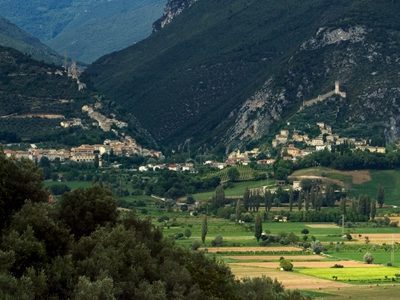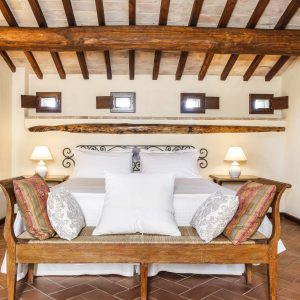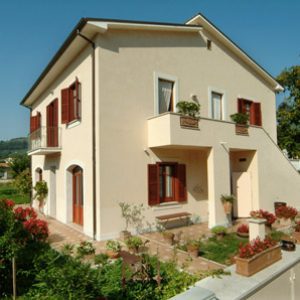▌ Discover Ferentillo
#BELLAUMBRIA
{“translation”:[{“lang”:”it”,”content”:”
Ferentillo, posto a 252 metri sul livello del mare, si trova sulla Valnerina a 17 chilometri dalla citta’ di Terni. I castelli di Precetto a sinistra e di Matterella a destra, con i loro bastioni, sembrano ancora proteggere il borgo che si trova alle loro spalle, ai piedi degli stessi monti Sant’Angelo e Gabbio sui quali essi si innalzano.

>> Ci sono offerte in scadenza per agriturismi nella zona di Ferentillo! Clicca e consultale subito.
Il nome Ferentillo deriva dall’espressione: “quelli di Ferento” (Ferentum illi). Infatti, nel 742, il re Liutprando, in lotta con il duca di Spoleto, portò con se i coloni e gli armigeri della città di Ferentum, da cui appunto Ferentum illi.
Oltre le rocche di cui si è detto, entrambe trecentesche, rimangono a Ferentillo bei resti delle mura medioevali erette a difesa della valle. All’interno del paese, da notare la chiesa di Santo Stefano, del XV secolo. Il visitatore che entra nella cripta trecentesca di questa chiesa, rimane incredulo nel vedere tra un gioco di archi ed affreschi del sec. XV, l’irreale spettacolo di Corpi Mummificati che in alcuni casi mantengono peli, capelli, denti ed abiti e che in altri casi denunciato la causa della morte. Questi corpi sono stati scoperti quando, nel rispetto dell’editto di Sant Claude, furono riesumate le salme sepolte all’interno della chiesa. Da allora il processo di mummificazione è stato lungamente studiato, senza però giungere ad una conclusione sicura. Gli scienziati parlano di una mistura vari sali, nonchè di ammoniaca, che unita alla ventilazione ed alla decomposizione di microorganismi, ha lentamente essiccato la pelle dei cadaveri.
A pochi chilometri da Ferentillo, è assolutamente da non perdere l’Abbazia di San Pietro in Valle, dell’VIII secolo, con pregevolissimi affreschi dell’ XI e XII secolo.
Ogni anno, l’ultima settimana di agosto, nel paese ha luogo una manifestazione nella quale, attraverso dei quadri viventi inseriti nel paese medioevale, si racconta la storia Ferentillese dalle origini al 1918. Ferentillo è inoltre famosa a livello internazionale per l’Arrampicata Sportiva, grazie alle sue palestre di roccia, fruibili tutto l’anno.
“},{“lang”:”en”,”content”:”Ferentillo, placed at 252 metres above sea level, is situated along the Valnerina valley at 17 kilometres’ distance from the city of Terni. The castle of Precetto on the left- hand side and the castle of Matterella on the right with their bastions still seem to protect the town which is to be found behind them, below the mountains of Sant’Angelo and Gabbio from which the castles rise up.
The name of Ferentillo is due to the expression: “those of Ferento” (Ferentum illi). In fact, in 742, King Liutprando, at that time battling with the Duke of Spoleto, took with him the the settlers and the warriors of the city of Ferentillo, therefore “Ferentumilli”.
Apart from the rocks of which we have already spoken, at Ferentillo a great part of the medieval town walls, which were erected to defend the valley, still remain. Inside the town itself, the church of St. Stefano, dating back to the 15th century, is noteworthy. A visitor on entering the crypta dating back to the 4th century remains incredulous at the sight of not only arches and frescoes of the 16th century, but at the unreal spectacle of the Mummified Bodies, which, in some cases, have preserved hair, teath and clothes, and which, in others, show the cause of death. The mummies were discovered when the bodies buried inside the church were exhumated due to the edict of Sant Claud. Afterwards, the process of mummification was studied for a long time, without, however, arriving at a definite conclusion. Scientists speak of a mixture of vaious salts and ammonia, which, added to ventilation and the decomposition of micoorganisms, has slowly dried up the skin of the corpses.
The Abbey of San Pietro in Valle, dating back to the 9th century, with its noteworthy frescoes of the 12th and 013th centuries, absolutely should not be missed.
Every year from 1918 onwards, during the last week of August, a show takes place in the town which recounts the history of Ferentillo with living tableaux which are to be found in the medieval part of the town. Ferentillo is also internationally famous for its Free Climbing. Its rock gymnasium can be used all around the year.
“},{“lang”:”es”,”content”:”Ferentillo, placed at 252 metres above sea level, is situated along the Valnerina valley at 17 kilometres’ distance from the city of Terni. The castle of Precetto on the left- hand side and the castle of Matterella on the right with their bastions still seem to protect the town which is to be found behind them, below the mountains of Sant’Angelo and Gabbio from which the castles rise up.
The name of Ferentillo is due to the expression: “those of Ferento” (Ferentum illi). In fact, in 742, King Liutprando, at that time battling with the Duke of Spoleto, took with him the the settlers and the warriors of the city of Ferentillo, therefore “Ferentumilli”.
Apart from the rocks of which we have already spoken, at Ferentillo a great part of the medieval town walls, which were erected to defend the valley, still remain. Inside the town itself, the church of St. Stefano, dating back to the 15th century, is noteworthy. A visitor on entering the crypta dating back to the 4th century remains incredulous at the sight of not only arches and frescoes of the 16th century, but at the unreal spectacle of the Mummified Bodies, which, in some cases, have preserved hair, teath and clothes, and which, in others, show the cause of death. The mummies were discovered when the bodies buried inside the church were exhumated due to the edict of Sant Claud. Afterwards, the process of mummification was studied for a long time, without, however, arriving at a definite conclusion. Scientists speak of a mixture of vaious salts and ammonia, which, added to ventilation and the decomposition of micoorganisms, has slowly dried up the skin of the corpses.
The Abbey of San Pietro in Valle, dating back to the 9th century, with its noteworthy frescoes of the 12th and 013th centuries, absolutely should not be
missed.
Every year from 1918 onwards, during the last week of August, a show takes place in the town which recounts the history of Ferentillo with living tableaux which are to be found in the medieval part of the town. Ferentillo is also internationally famous for its Free Climbing. Its rock gymnasium can be used all around the year.
“},{“lang”:”de”,”content”:”Ferentillo, placed at 252 metres above sea level, is situated along the Valnerina valley at 17 kilometres’ distance from the city of Terni. The castle of Precetto on the left- hand side and the castle of Matterella on the right with their bastions still seem to protect the town which is to be found behind them, below the mountains of Sant’Angelo and Gabbio from which the castles rise up.
The name of Ferentillo is due to the expression: “those of Ferento” (Ferentum illi). In fact, in 742, King Liutprando, at that time battling with the Duke of Spoleto, took with him the the settlers and the warriors of the city of Ferentillo, therefore “Ferentumilli”.
Apart from the rocks of which we have already spoken, at Ferentillo a great part of the medieval town walls, which were erected to defend the valley, still remain. Inside the town itself, the church of St. Stefano, dating back to the 15th century, is noteworthy. A visitor on entering the crypta dating back to the 4th century remains incredulous at the sight of not only arches and frescoes of the 16th century, but at the unreal spectacle of the Mummified Bodies, which, in some cases, have preserved hair, teath and clothes, and which, in others, show the cause of death. The mummies were discovered when the bodies buried inside the church were exhumated due to the edict of Sant Claud. Afterwards, the process of mummification was studied for a long time, without, however, arriving at a definite conclusion. Scientists speak of a mixture of vaious salts and ammonia, which, added to ventilation and the decomposition of micoorganisms, has slowly dried up the skin of the corpses.
The Abbey of San Pietro in Valle, dating back to the 9th century, with its noteworthy frescoes of the 12th and 013th centuries, absolutely should not be missed.
Every year from 1918 onwards, during the last week of August, a show takes place in the town which recounts the history of Ferentillo with living tableaux which are to be found in the medieval part of the town. Ferentillo is also internationally famous for its Free Climbing. Its rock gymnasium can be used all around the year.
“},{“lang”:”fr”,”content”:”Ferentillo, à 252 mètres au-dessus du niveau de la mer, se trouve dans la Val Nerina à 17 kilomètres de la ville de Terni. Les châteaux de Precetto à gauche et de Matterella à droite, avec leurs bastions, semblent encore protéger le village qui se trouve derrière, aux pieds des mêmes monts Sant’Angelo et Gabbio sur lesquels ils se dressent.
Le nom Ferentillo dérive de l’expression: “ceux de Ferento” (Ferentum illi). En effet, en 742, le roi Liutprando, en guerre contre le duc de Spoleto, amena avec lui les colons de la ville de Ferentum, dont vient justement Ferentum illi.
Outre les châteaux dont on a parlé, tous les deux du XIV siècle, il reste également à Ferentillo de beaux restes des murs médiévaux construit pour défendre la vallée. A l’intérieur du village il faut souligner l’église de Saint Stéphane, du XV siècle.
Le visiteur qui entre dans la crypte du XIV siècle de cette église reste incrédule en admirant, entre un jeux d’arches et de fresques du XV siècle, le spectacle irréel de Corps Momifiés qui, dans certains cas ont encore poils, cheveux, dents et vêtements et dont, dans d’autres cas, on peut identifier la cause de la mort. Ces corps ont été découverts quand, dans le respect de l’édit de Saint Claude, furent exhumés les cercueils enterrés à l’intérieur de l’église. A partir de là le processus de momification a été longuement étudié, sans pour autant aboutir à une conclusion sure. Les scientifiques parlent d’un mélange de divers sels, ainsi que d’ammoniaque, qui avec la ventilation et la décomposition de micro-organismes, a lentement séché la peau des cadavres.
A quelques kilomètres de Ferentillo, il ne faut absolument pas rater l’Abbaye de San Pietro in Valle, datant du VIII siècle, avec de précieuses fresques des XI et XII siècles.
Tous les ans, au cours de la dernière semaine d’août, se déroule dans le village une manifestation au cours de laquelle, à travers des cadres vivants insérés dans le village médiéval, on raconte l’histoire de Ferentillo, de ses origines à 1918. Ferentillo est en outre connue au niveau international pour l’Escalade Sportive, grâce à ses parois rocheuses, que l’on peut utiliser toute l’année.
“}]}


